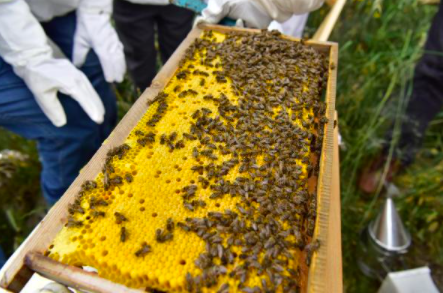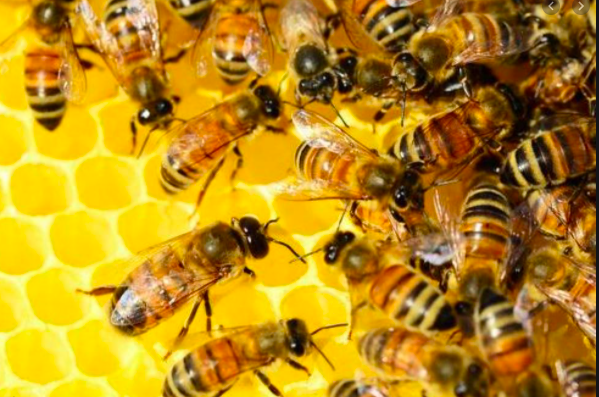A lot of people are unaware of what beekeeping is and that it is an actual practice and profession. Beekeeping is one of the oldest honey-gathering traditions in India. Due to its market demand in national and international markets as well, honey bee agriculture is becoming popular. Farmers not only yield a sweet dividend, but beekeeping also helps to increase the productivity of agriculture by pollination. Honeybees also produce pollen, bee wax and royal jelly, providing farmers with additional benefits. Farmers are usually inclined towards bee farming following successive losses in traditionally grown crops. Honeybees can be used as an effective input agent in order to increase agricultural production.
Around 80 percent of crops are cross-pollinated because, with the aid of external agents, pollen from other plants of the same genus needs to be collected. The honeybee is among the most significant external agents. Farmers considering commercial honey bee farming should consider training in the area of apiculture. A colony is normally made up of a queen, several thousand workers, and a few hundred drones. In the output of different roles, there is a division of labor and specialization. They build nests with wax called “combs,” which is secreted from the wax glands of worker bees. To rear thin brood and store food, the bees use their cells. Honey is contained in the upper part of the comb.
There should be rows of storage cells for pollen, worker brood cells, and drone brood cells under the comb. Many bee species produce a single comb in the open, where several combs are built on dark cavities like others. Honeybees may be used by farmers for their pollination services or to obtain goods from them. The techniques used depend on the type of bees available, and the beekeeper’s expertise and resources available.

A study found that crop yields increased by a substantial median of about 24 percent if pollination is well handled, and efficient pollination of flowers also helps protect crops against pests. In current situations, beekeeping is therefore the best agri-business, particularly in rural areas, where it can act as a secondary source of extra income. Things such as royal jelly, bee wax, pollen, propolis, and bee venom are also marketable at a reasonable price and can help farmers increase their profits.
Check out the 7 reasons Why you should consider beekeeping on our blog.
Why is it important to produce Bees optimally for beekeeping
Beekeeping, as discussed above, can transform your business and surplus and harvest as a farmer. Hence it is important that one uses it to its full capacity. Honeybees don’t provide with just one benefit. Not only do they give honey, but also various other products like beeswax. Other than providing with sellable goods, honeybees are excellent pollinators. They perform great cross pollination, which is something that is an additional service with bee farms. With so many benefits, it is important that farmers utilise bee farms optimally.
By making sure that you get good and correct equipment, good quality bees and consistent care and management one can make sure that they utilize their bee-farm to its fullest capacity ad get maximum utilization out of it. Farmers should make sure that they use each benefit to their advantage, since it can help them increase their income and produce by great amounts. Here are some tips and techniques that can help you do the same.
Get to know What is Natural Farming here.
Tricks and techniques to optimize Bee producing while doing beekeeping
Now let’s talk about how you can start a beefarm and some techniques and pointers that will make the process easier for you.
First lets talk about the tips that will help you get started with your beefarm:
- The first step in planning a beekeeping project is to get to know the bee-human relationship you want to set up in your field. Find out more about bees by literally participating.
- Working with local beekeepers is recommended, particularly if you have no experience of working with bees. Learn and follow their beekeeping management advice. Having bee stings is very widespread and they are part of beekeeping.
- When you have become familiar with the local bee-human relationship, suggestions should be developed to implement enhanced techniques and then create a perfect strategy for the use of equipment and where to sell hive items.
- If you are just starting with bees, expect to operate in the region with just 1 or 2 people.
- Starting beekeeping with at least 2 hives is advisable. This provides an opportunity to compare the success of a number of hives if one colony dies out, which helps the project to proceed. Management directed at an apiary rather than individual hives may also be stressed out.
- Set achievable targets when planning a project and go for a small project first, then it is better off for a big one after having experience in beekeeping.
- In a project, the equipment to be used depends on the local situation. In deciding what type or types of hive equipment is suitable for your area and type of bees, you can consider the availability of required inputs as well as the technical assistance available.
- Equipment for beekeeping plays an important role in the success of the enterprise. It can be a success in itself to find people in a region who can make beekeeping equipment and get it made. The planning of bringing the equipment together will take a lot of patience.

- Identify any local agent or negotiate with a market already developed in order to market hive goods. For marketing opinions, find out with other beekeepers. Farmers may also get in contact with local agriculture departments. Typically, a possible market for honey is local bakers and candy makers.
Read about commercial farming and its benefits here. https://rocketskills.in/what-is-commercial-farming/
Now let’s talk about the tips and tricks that will help you successfully run the business and will help you with any small issues that you might face with your bees:
- The ideal spot for your beefarm should be easily accessible by car, or at least have some way to transport heavy boxes full of honey. Just because making a bee colony far down an isolated trail would look good doesn’t mean it’s the best spot. Your bees should be conveniently placed in a position that can be reached frequently.
- Bees do well when the entrance of the hive faces south, receiving heat from the sun. A shady place is not ideal.
- Bees can “drift” unintentionally through neighbouring colonies. Therefore, if you have lined up all of your colonies in a row, all painted the same colour, and all facing the same direction, it’s easy for bees to make mistakes in orientation and end up in the wrong colony. A sick bee can therefore easily end up in the neighbouring colony and spread illness within the apiary. Holding colonies further apart (like 30 metres) is not feasible for many beekeepers, but if you are able to, it is helpful to give the colonies a bit more room. Painting the various colours of the hive boxes would also help.
- Do not work on a stormy day with bees or if a storm is approaching. Bees are sensitive to air pressure changes. Also, if you smell like bananas, they are more likely to bite. Before dealing with bees, don’t eat them.
You can also check out our course on Beekeeping and Beefarming here at Rocket Skills.
We hope that this blog solves most of your doubts on whether beekeeping is a field that you should be foraying in. You can also check out our other blog highlighting everything you need to know about beekeeping in India here!


One Response
Can you make the complete course on how to keep bee keeping? ( business view point)